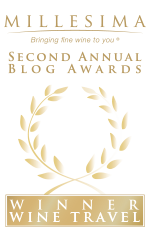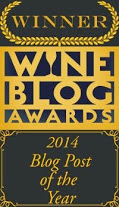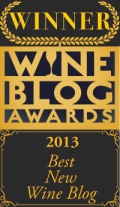 |
| Photo Credit: Dede Hatch |
If you missed my column Unscrewed, here’s a second look at my interview with Finger Lakes winemaker Kim Engle of Bloomer Creek.
Kim Engle pauses mid-sentence as his eyes drift to the window. Looking uneasy, he peers through the foggy pane at his vineyards: “Sorry, the rain made me lose concentration; it makes me nervous.” For four summer days, the rain had been driving down in unseasonably high quantities; that morning, the sound of water pounding the roof was like marbles unleashed from the sky. For a vineyard owner, the weather was frightening — particularly when trying to farm organically.
I was visiting the Finger Lakes to understand firsthand this fast-growing region of New York. Much had been written about Finger Lakes Rieslings. Occasionally, critics bestowed upon the region honorific titles like “world-class” or references to “Riesling on par with the Mosel,” yet the wines weren’t commonplace in shops or on wine lists.
Asking colleagues in the wine industry for producers I should visit, the name Kim Engle, followed by the phrase “I love Bloomer Creek wines,” popped up repeatedly. Bloomer Creek wasn’t well-known, wasn’t publicly lauded like Weimer or Dr. Konstantin Frank, household Finger Lakes winery names. “Find Kim Engle. His Pinot Noir Freaked. Me. Out.” another wine writer gushed. I felt privy to a secret — like a hot stock tip written on a folded napkin.
Christy Frank, owner of Frankly Wines in Tribeca, stocks a few Finger Lakes producers, including Bloomer Creek. “I love their wines. I like that they are working relatively naturally in difficult conditions, with small quantities, and are taking risks to make wines that taste of terroir.”
I found Engle at his winery on the east side of Seneca Lake. Standing inside the rustic re-creation of a French country carriage house he and his wife, Deborah Bermingham, finished building in 2007, we chatted through the outlandish storm. Engle seems humbled by it all — an artisan and farmer in awe of the earth.
Engle got his start in wine through farming; he started working local jobs during a leave of absence from Cornell at age 19. He milked cows, worked on an organic grain farm, and grew his own vegetables. “I got a job for what is now Hosmer Winery over on Cayuga,” he says. “At that point, it was just a vineyard, and I fell in love with it.”
Engle met his now wife, then a fellow Cornell student, through a friend. Although an accomplished artist, Bermingham decided to make wine together with Engle from the beginning. Different vineyard practices have come and gone since getting their winery license in 1999. “For 10 years, I was NOFA-NY certified organic, but I stopped certification for a variety of reasons,” he says. “With grapes, at the time, there was virtually no market.”
Giving up the certification meant Engle could combat vineyard disease pressure like downy mildew, a nasty microbe that thrives in the humid, wet weather prevalent in the FLX, with synthetic spray. But Engle has already converted one acre of his currently planted fourteen (they’ve recently bought another twelve acres) back to organic, and says he’s headed in that direction, and ultimately fully biodynamic, for the rest of their vines. “I tried using sprays but the problem with this kind of chemical—Pristine is one brand name—is that grapes develop resistance very quickly. The result is that everybody then adds more chemicals to the mix because Pristine may not control it [downy mildew] anymore. But nobody knows for sure, so why we are still using it?”
To ease the transition back to organic farming, Engle converted a number of his rows to a labor-intensive trellis system that separates the vines and allows for greater air circulation. This helps grapes dry faster in wet conditions.
Unlike his viticultural program, which has meandered back to the organic philosophy, Engle’s winemaking had a definite turning point. In 2008, a customer brought him a few bottles of natural wine from the Loire Valley. He had an epiphany, astounded at how fresh and alive the wines tasted; this led to a complete overhaul of their winemaking approach. “[Loire winemakers] took a minimalist approach to winemaking, and with a lot less rushing of the process overall,” he says. By 2010, Engle stopped using cultured yeasts; white wines saw some skin contact; he experimented with adding stems; and finished wines saw very little filtering or fining.
What was he doing before that? “There was a time, going back 20 years, when I worked at another winery, and we were all happy just winning medals and ‘making’ wine — highly processed, technical, safe wines.”
When I asked if people still produce wine that way, Engle shifted his weight, and gave a little cough. We’d obviously entered touchy territory: “I can’t say what my colleagues do. But, take a look at the Scott Labs catalogue—there are two pages devoted to tannin products.”
Engle picked up a bottle of his Tanzen Dame Dry Riesling, poured a splash, then continued: “Rather than take risks, it’s easier to start with a flavorless, boring base wine then add in the parts—the tannin, the acid. There was a winemaker who had been up here a long time who said at a conference one day ‘everyone says good wine is made in the vineyard, but I just want to be clear, I make the wine in the cellar.’ If that doesn’t tell you something… “
In addition to Gewürztraminer, Chardonnay, Cabernet Franc, Pinot Noir, and now a little Grüner Veltliner, Engle and Bermingham produce a lot of Riesling, both dry and off-dry. “I am a Riesling lover, and it does well here,” he says. “Fortunately, the outside world is finally responding to it.”
The outside world includes Thomas Pastuszak, wine director of the NoMad Hotel, who was impressed enough to give Bloomer Creek Riesling a spot on the prestigious wine list. Scott Pactor of Appellation Wine and Spirits in Chelsea declared their Rieslings “some of the best in New York if not the entire U.S.”
My visit with Engle confirmed the sentiments of industry insiders. His wines taste and feel a bit different in the mouth: less precise and neat, rather, unfurling in waves of flavor like a blooming tea flower. Amazingly, the wines only trade around $20 a bottle; for wine lovers, that’s a lot of potential upside for such a minor investment.
Planning to visit the region? Get itinerary advice and wine tips from my Wine Lover’s Guide to the Finger Lakes.









